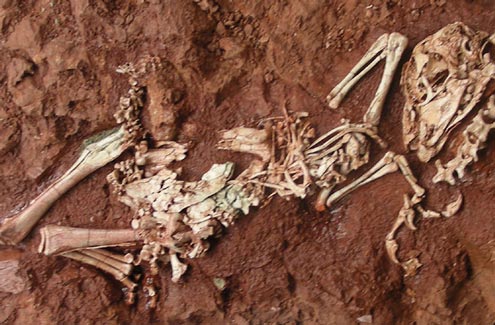Juvenile Oviraptorids (Chicken-sized Dinosaurs) and a New Species
Fossils Provide Evidence of How Oviraptorids Grew Up
The bird-like oviraptorids which are known mainly from Upper Cretaceous strata from Mongolia and China are a very specialised group of dinosaurs that belong to the Suborder theropoda. Despite a number of recent fossil discoveries, palaeontologists have still much to learn about these dinosaurs. However, the discovery of a large number of oviraptorid specimens including five juveniles has helped scientists to erect a new genus and to learn a little about how these dinosaurs grew from babies into adults.
New Oviraptorid Dinosaur
The newest member of the Oviraptoridae is represented by the smallest specimens of Oviraptors discovered to date, the five individual specimens measure between 25 cm and 50 cm in length. This newly discovered dinosaur has been named Yulong mini, the fossils were excavated from the Qiupa Formation of Upper Cretaceous strata from the Henan Province (eastern China). The geological age of the Qiupa Formation is debated. However, the presence of a number of dinosaur fossils including oviraptorids, dromaeosaurs and ornithomimids indicate that this strata was most probably laid down towards the very end of the Cretaceous period.
The name of this new dinosaur, is derived from the Chinese name for Henan Province coupled with the Chinese word for dragon and the specific name refers to the tiny size of these reptiles, so the name translates as “tiny dragon from Henan”.
Fossils of the New Oviraptorid Y. mini
Picture credit: Junchang Lu (lead author)
Yulong mini
The baby dinosaurs are the subject of a scientific paper published in the journal “Naturwissenschaften”. Chinese researchers from the Henan Geological Museum and the Chinese Academy of Sciences wrote this paper in conjunction with the Canadian palaeontologist Phil Currie, who has worked extensively on Late Cretaceous Theropod dinosaurs from this part of the world.
Writing about the discovery, lead author Junchang Lu commented that:
“These dinosaurs looked like chickens with a tail. Their behaviour was probably very similar to that of a modern bird. When compared to primitive Oviraptorids such as Caudipteryx, Yulong should be feathered, although no evidence of feathers were found due to the poor preservation condition of the fossil material and the coarse characteristics of the surrounding matrix.”
Several dinosaur specimens were found at this location, but these juvenile dinosaurs perhaps represent the most important vertebrate fossils found to date as they permit palaeontologists to piece together information about how these dinosaurs grew. A number of ontogenetic characteristics have been identified helping scientists to understand how these creatures matured into adult animals. The skulls are not yet fully fused and the babies do show different body proportions in comparison with adult oviraptorids.
Limb Proportions
Intriguingly, the hind limb proportions (ratio of upper leg bones to lower leg bones) femur: tibia/fibia remain constant in oviraptorids. The younger dinosaurs have the same hind limb proportions as older animals. This suggest that these dinosaurs were not particularly fast runners and may have a had a much more sedentary habit. It is unlikely that these types of dinosaur pursued and fed upon animals roughly equal in size to themselves.
A number of adult specimens were also found at this site, although they were not found in close association with the chicken-sized juveniles. It can be speculated that as the babies were found apart from the adults, the youngsters may have been very independent from birth – perhaps an indication of precocial behaviour. Precocial offspring are born or hatched as relatively well-developed animals that show a high degree of independence from the adult animals. Many types of modern bird show this type of behaviour.
To view models and replicas of oviraptorids and other feathered theropods: Wild Safari Wild Dinos Models and Figures.
The diet of these creatures remains uncertain. Studies of the skull and jaws of Y. mini when related to the hind limb proportions which indicate a more sedentary lifestyle, suggest that these oviraptorids may have been herbivorous feeding on leaves, ferns and even flowers and fruit. However, the bite force calculated from measurements of the jaw size and muscle area of the juveniles is still considerable and it is not possible to rule out that these dinosaurs may have also eaten small animals such as lizards, mammals and even younger members of their own species.
Perhaps this is another reason why the babies tended to keep out of the way of the adults.
The scientific paper: “Chicken-sized oviraptorid dinosaurs from central China and their ontogenetic implications” by Junchang Lü, Philip J. Currie, Li Xu, Xingliao Zhang, Hanyong Pu and Songhai Jia published in Naturwissenschaften.


